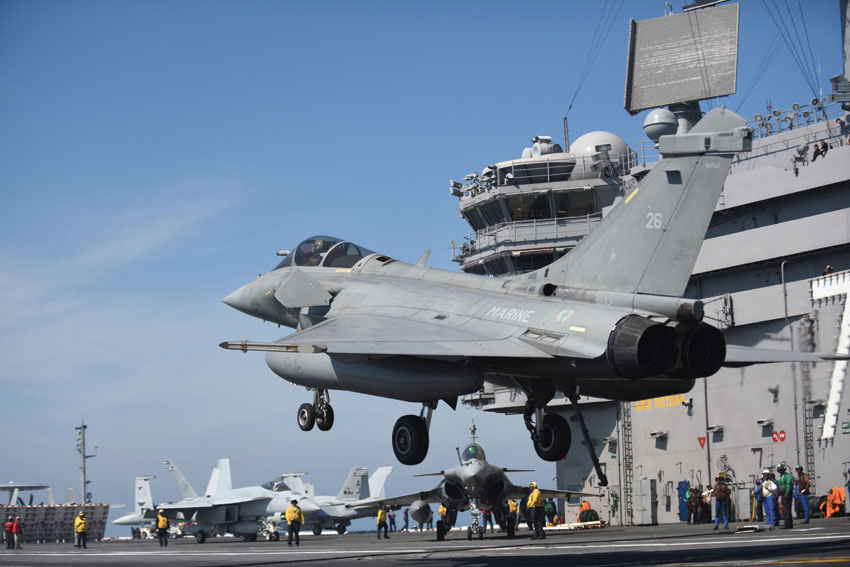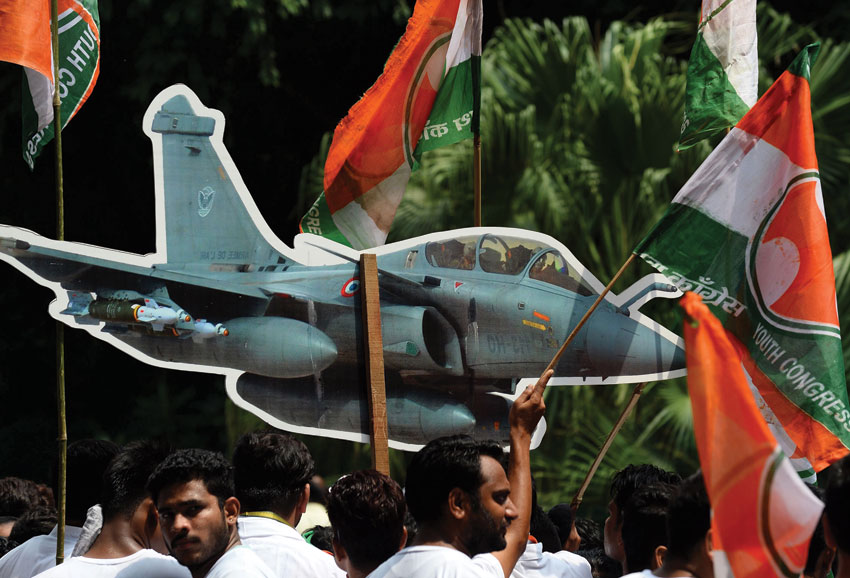Decoding the Rafale Deal: From Allegations to Counter-allegations
Supporters of the opposition Indian National Congress party hold a model of a Rafale fighter jet as they shouts slogans during a protest against the Rafale jets deal, in New Delhi, Aug. 30. The Rafale deal has been caught in a controversy with the opposition Congress alleging that the price being paid by the government to purchase 36 fighter jets is more that what it had negotiated for. The government has denied the allegation and refused to divulge the cost citing a confidentiality clause in the purchase agreement. (Sajjad Hussain/AFP/Getty Images)
As the controversy surrounding Rafale deal escalates, here is an explainer and a timeline relating to India’s purchase of 36 combat jets from France for an estimated Rs.58,000 crore.
What is Rafale:Rafale is a French twin-engine multi-role fighter jet designed and built by Dassault Aviation. The Rafale jets are considered one of the most potent combat jets globally.
The UPA deal:India began the process to buy a fleet of 126 Medium Multi-Role Combat Aircraft (MMRCA) in 2007 after the Defense Ministry, headed then by Congress leader A.K. Antony, cleared the proposal from the Indian Air Force.
The contenders for the mega deal were Lockheed Martin’s F-16s, Eurofighter Typhoon, Russia’s MiG-35, Sweden’s Gripen, Boeing’s F/A-18s and Dassault Aviation’s Rafale.
After a long-drawn process, bids were opened in December 2012 and Dassault Aviation emerged as L-1 (lowest bidder). In the original proposal, 18 planes were to be manufactured in France and 108 in India in collaboration with the Hindustan Aeronautics Ltd.
There were lengthy negotiations between the then UPA government and Dassault on prices and transfer of technology. The final negotiations continued till early 2014 but the deal could not go through.
Details of the negotiated price per Rafale were not officially announced, but it was suggested by the then UPA government that the size of the deal would be $10.2 billion. The Congress claimed per aircraft rate including avionics and weapons was zeroed in at Rs.526 crore (As per Euro exchange rates prevailing then).
The Deal Finalized by Modi Government: During his visit to France, Prime Minister Narendra Modi on April 10, 2015, announced India will purchase 36 Rafale jets in a government-to-government agreement. After the announcement, questions were raised by the Opposition on how the PM finalized the deal without approval of the Cabinet Committee on Security.
A joint statement issued on April 10, 2015, after talks between Modi and then French President François Hollande,said they agreed to conclude an Inter-Governmental Agreement for supply of 36 Rafale jets on terms that would be better than conveyed by Dassault Aviation as part of a separate process underway.
The statement said the aircraft and associated systems and weapons would be delivered on the same configuration as had been tested and approved by Indian Air Force, in clear reference to negotiations and testing process for the Rafale jets under the UPA government.

The Final Deal: India and France signed a Euro7.87 billion (Rs.59,000 crore approximately) deal on Sept. 23, 2016, for 36 Rafale jets. The delivery of the aircraft will start from September 2019.
The deal was finalized on the basis of the procurement procedure followed under the UPA government.
The Allegations: The Congress has been accusing massive irregularities in the deal, alleging that the government was procuring each aircraft at a cost of over Rs.1,670 crore as against Rs.526 crore finalized by the UPA government. The party has also demanded answers from the government on why state-run aerospace major HAL was not involved in the deal.
The Congress has also sought to know price details of the aircraft and how the rate per aircraft has gone up from Rs.526 crore to Rs.1,670 crore. The government has refused to share the details, citing a secrecy clause of a 2008 pact between India and France.
Congress’ A.K. Antony, who was defense minister in 2008 when India and France inked an inter-governmental agreement on defense procurement, said the government’s claim that the secrecy clause was forcing it to not reveal price details of the deal was “totally wrong.”
The party claimed that Qatar had purchased 12 Rafale fighter jets in November 2017 for $108.33 million per aircraft (Rs.694.80 crore).
The Congress has also alleged the government was benefitting Reliance Defense Ltd. (RDL) through the deal as the company has set up a joint venture with Dassault Aviation to execute the offset obligation for the Rs.59,000 crore deal.
The has party alleged Reliance Defense was formed just 12 days before the announcement of the Rafale deal by the prime minister on April 10, 2015. RDL has rejected all the charges.
Under India’s offset policy, foreign defense entities are mandated to spend at least 30 percent of the total contract value in India through procurement of components or setting up of research and development facilities.
On Oct. 3, 2016, RDL and Dassault Aviation announced a joint venture (JV) in the aerospace sector and a year later, foundation stone of a manufacturing facility was laid in Mihan, Nagpur.
The Government’s Response:Around two years back, Minister of State for Defense, while replying to a question in Parliament, had said the cost of each Rafale aircraft is approximately Rs.670 crore but did not give details of prices of associated equipment, weapons and services.
Later, the government refused to talk about the prices. It has been maintaining that the cost of 36 Rafale jets cannot be “directly compared” with the original proposal to buy 126 combat aircraft as “deliverables” were significantly different.
Finance Minister Arun Jaitley wrote a Facebook post, Aug. 29, accusing Congress and its leader Rahul Gandhi of “peddling untruth” and carrying out a “false campaign” on the deal. He said the deal signed by the NDA government was on better terms than the one agreed to in 2007 under the UPA regime.


